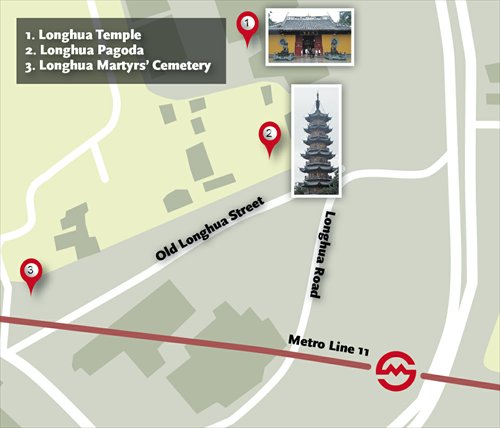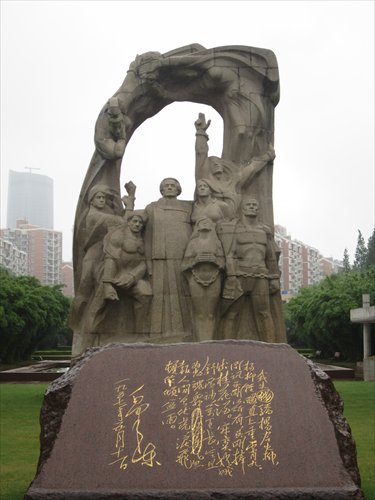Longhua Station
Ancient town engulfed by metropolis still holds on to precious history
Editor's note
This year is the 21st anniversary of the opening of the Shanghai metro. The subway has facilitated more than 13 billion journeys during its 21 years, and half of Shanghai citizens cite the metro as their favored mode of transport. To commemorate the anniversary, each week the Global Times will take an in-depth look at one metro station and its surroundings. In the case of downtown stations, we will focus on points of interest within walking distance; while for suburban areas, we will cast our net a little wider.
Lying in the southern part of Xuhui district, the ancient town of Longhua boasts a profound history dating back to the Song Dynasty (960-1279). A number of historic landmarks can be easily accessed from Exit 2 of Longhua Station on metro Line 11, offering a rare glimpse into some of the city's rich past.

map
Longhua Temple
Built in the year AD242 during the Three Kingdoms period (220-280), Longhua Temple (2787 Longhua Road, 6457-8777) is among Shanghai's oldest temples, though it has gone through constant renovations over the past 1,800 years.
Having withstood the ravages of both time and gunfire, the temple maintains its tranquil stature, and is pervaded by the smell of burning incense and the sounds of prayers.

A statue inside the Longhua Martyrs' Cemetery Photos: Yang Fan/GT
Stepping through the chipped and faded gate of the temple complex, you will soon find yourself breathing the Buddhist temple air, and quickly become immersed in the world of tranquility.
The whole temple is elegantly laid out according to traditional Buddhist symmetry. Along its 194-meter-long north-south axis stand four Buddhist shrines, namely the Maitreya Hall, the Heavenly King Hall, the Mahavira Hall and the Three Sages Hall. Adjoining buildings like the Bell Tower and the Drum Tower are arranged off the central axis, but still in a perfect symmetrical formation.
The Mahavira Hall houses an elaborate gilded effigy of the Sakyamuni Buddha seated on a lotus flower flanked by 18 disciples. The Three Sages Hall features three incarnations of the Buddha sitting beneath an exquisitely carved swirl-patterned red dome. The Arhats' Hall impresses with a legion of 500 glittering golden figurines of enlightened arhats (disciples) in rows, each of them vivid and unique.
Wish trees standing between the shrines are draped with numerous red ribbons bearing people's wishes for fortune and good health.
The temple is at its most vibrant on the first and 15th day of each lunar month, as they are believed to be the best days for praying.
A ritual countdown ceremony is held in the temple on the eve of the Chinese New Year when a 2-meter-high antique bronze bell is struck 108 times (a sacred number in Buddhist philosophy) and anyone who hears the bell is said to be blessed for the coming year. Fireworks and lion dances on the temple square also contribute to the festive air.
Visitors can get some complimentary joss sticks with their 10 yuan ($1.62) admission ticket. Bringing burning incense into shrines is not allowed due to fire safety concerns.
The temple is open from 7 am to 4:30 pm daily, except for the first and the 15th day of each lunar month, when it opens from 5 am to 4:30 pm.
Longhua Pagoda
Standing majestically at around 40 meters high, Longhua Pagoda (2853 Longhua Road, 6456-6085) is said to have been built by emperor Sun Quan of Wu (222-280) during the Three Kingdoms in an effort to house Sharira relics, or cremated remains of the Buddha.
A brick-and-wood octagonal structure with seven balcony-encircled stories, the building features black tiles, yellow walls, wooden staircases and curved upturned eaves from which 56 tiny bells are suspended. It has been rebuilt several times, but still retains the style of the Song Dynasty.
In British author J. G. Ballard's semi-autobiographical novel Empire of the Sun, the pagoda is described as being used as a flak cannon tower by the Japanese army during the World War II.
Steven Spielberg's award-winning film adaptation of the book features the pagoda, which can be clearly seen in the film near the Japanese-run internment camps, where numerous allied civilians were held under harsh conditions.
Due to its age and fragility, the pagoda is not open to the public, and can only be admired from a distance.
Longhua Martyrs' Cemetery
Longhua Martyrs' Cemetery (180 Longhua Road West, 6468-5995) is the resting place for 1,700 martyrs who laid down their lives during the Agrarian Revolutionary War (1927-37), the War of Resistance against Japanese Aggression (1937-45) and the War of Liberation (1945-49).
It used to be the site of the Song-Hu Garrison Headquarters of the Kuomintang (KMT), where suspected Communists were imprisoned and executed.
The lush green space inside the park is dotted with imposing statues of soldiers. Located at the far end is a striking sculpture of an unknown soldier lying on his side with one arm held up to the sky. The statue, titled The Unknown Martyrs, commemorates the millions of unsung heroes who sacrificed themselves for the country's revolutionary cause. A flame burns in front to represent their heroic spirit.
A pyramid-shaped memorial museum located in the park's center exhibits photos and historical relics, some dating back as far as 1840, from over 200 revolutionaries who were active in Shanghai.
A forest of stone tablets in the east of the park showcases stone-engraved poems and articles written by Chinese revolutionary forerunners like Lu Xun (1881-1936) and Li Dazhao (1889-1927).
Also housed in the cemetery is an inconspicuous memorial hall, where the ashes of over 500 revolutionary martyrs are kept. There is no admission charge to the cemetery, which is open from 6 am to 5:30 pm daily. Last admission is 5 pm.